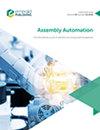大跨度航天装配结构自动钻孔组合孔位误差修正方法
IF 1.7
4区 计算机科学
Q3 AUTOMATION & CONTROL SYSTEMS
引用次数: 2
摘要
用途航空航天装配对紧固件孔的钻孔定位精度要求很高。孔位误差校正是满足孔位精度要求的关键问题。本文旨在提出一种组合孔位误差校正方法,以达到较高的定位精度。基于航天结构形状的双线性插值曲面函数能够处理非重力变形的位置误差。为了有效地修正重力引起的变形误差,建立了基于力学理论的重力变形模型。采用平均、最小二乘和遗传优化三种求解策略求解重力变形模型中的系数,进一步提高定位精度和效率。实验验证表明,本文提出的组合位置误差校正方法将紧固件孔的位置误差从1.106 mm显著降低到0.123 mm。与传统力学理论方法相比,总位置误差减小了43.49%。研究局限/启示位置误差相关方法的精度可以达到毫米或亚毫米尺度,可能无法满足更高的精度。实际意义所提出的位置误差校正方法已应用于自动钻孔机中,保证了钻孔位置精度。社会意义提出的位置误差方法可促进自动钻铆加工系统在航空航天工业中的广泛应用。提出了原创性/价值组合位置误差校正方法和完整的误差补偿路线图。紧固件孔位精度稳定降低到0.2 mm以下,满足航空结构装配要求。本文章由计算机程序翻译,如有差异,请以英文原文为准。
A combined hole position error correction method for automated drilling of large-span aerospace assembly structures
Purpose
Aerospace assembly demands high drilling position accuracy for fastener holes. Hole position error correction is a key issue to meet the required hole position accuracy. This paper aims to propose a combined hole position error correction method to achieve high positioning accuracy.
Design/methodology/approach
The bilinear interpolation surface function based on the shape of the aerospace structure is capable of dealing with position error of non-gravity deformation. A gravity deformation model is developed based on mechanics theory to efficiently correct deformation error caused by gravity. Moreover, three solution strategies of the average, least-squares and genetic optimization algorithms are used to solve the coefficients in the gravity deformation model to further improve position accuracy and efficiency.
Findings
Experimental validation shows that the combined position error correction method proposed in this paper significantly reduces the position errors of fastener holes from 1.106 to 0.123 mm. The total position error is reduced by 43.49% compared with the traditional mechanics theory method.
Research limitations/implications
The position error correlation method could reach an accuracy of millimeter or submillimeter scale, which may not satisfy higher precision.
Practical implications
The proposed position error correction method has been integrated into the automatic drilling machine to ensure the drilling position accuracy.
Social implications
The proposed position error method could promote the wide application of automatic drilling and riveting machining system in aerospace industry.
Originality/value
A combined position error correction method and the complete roadmap for error compensation are proposed. The position accuracy of fastener holes is reduced stably below 0.2 mm, which can fulfill the requirements of aero-structural assembly.
求助全文
通过发布文献求助,成功后即可免费获取论文全文。
去求助
来源期刊

Assembly Automation
工程技术-工程:制造
CiteScore
4.30
自引率
14.30%
发文量
51
审稿时长
3.3 months
期刊介绍:
Assembly Automation publishes peer reviewed research articles, technology reviews and specially commissioned case studies. Each issue includes high quality content covering all aspects of assembly technology and automation, and reflecting the most interesting and strategically important research and development activities from around the world. Because of this, readers can stay at the very forefront of industry developments.
All research articles undergo rigorous double-blind peer review, and the journal’s policy of not publishing work that has only been tested in simulation means that only the very best and most practical research articles are included. This ensures that the material that is published has real relevance and value for commercial manufacturing and research organizations.
 求助内容:
求助内容: 应助结果提醒方式:
应助结果提醒方式:


